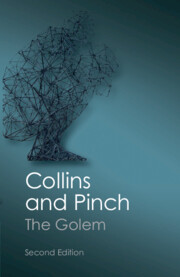Book contents
- Frontmatter
- Dedication
- Contents
- Preface to second edition
- Preface to first Canto edition
- Preface and acknowledgements
- Introduction: the golem
- 1 Edible knowledge: the chemical transfer of memory
- 2 Two experiments that ‘proved’ the theory of relativity
- 3 The sun in a test tube: the story of cold fusion 5
- 4 The germs of dissent: Louis Pasteur and the origins of life
- 5 A new window on the universe: the non-detection of gravitational radiation
- 6 The sex life of the whiptail lizard
- 7 Set the controls for the heart of the sun: the strange story of the missing solar neutrinos
- Conclusion: putting the golem to work
- Afterword: Golem and the scientists
- References and further reading
- Index
Conclusion: putting the golem to work
Published online by Cambridge University Press: 05 February 2014
- Frontmatter
- Dedication
- Contents
- Preface to second edition
- Preface to first Canto edition
- Preface and acknowledgements
- Introduction: the golem
- 1 Edible knowledge: the chemical transfer of memory
- 2 Two experiments that ‘proved’ the theory of relativity
- 3 The sun in a test tube: the story of cold fusion 5
- 4 The germs of dissent: Louis Pasteur and the origins of life
- 5 A new window on the universe: the non-detection of gravitational radiation
- 6 The sex life of the whiptail lizard
- 7 Set the controls for the heart of the sun: the strange story of the missing solar neutrinos
- Conclusion: putting the golem to work
- Afterword: Golem and the scientists
- References and further reading
- Index
Summary
Looking forward and looking back
We have followed several episodes of science as they have unfolded. We have described not only the work of the most revered scientists, the Einsteins, Newtons and Pasteurs, but also work which it appears will not be acclaimed: Joseph Weber's high fluxes of gravity waves and Ungar and McConnell's memory transfer. In some of the cases examined-the solar-neutrino problem and the sexual behaviour of the whiptail lizard-the jury is still out. Will they make it into the scientific canon or will they be scientific cannon fodder? It remains to be seen, but don't expect to find the answer in the experiments and theories alone.
It is no accident that we have chosen to look at high science and low science together. We have tried to level out the scientific mountain range which rises up as a result of the forces of celebratory history. Look back whence we came in science and there are what seem to be unconquerable peaks – Mount Newton, Mount Pasteur, Mount Einstein – a mountain range of truth. But look forward and the terrain is flat. A few new foothills wrench themselves from the plain every time we glance backwards. What are those new peaks? Were they there yesterday? To understand how science works we must examine how we cause these foothills and mountains to emerge. To do this we must understand science which fails as well as science which succeeds.
- Type
- Chapter
- Information
- The GolemWhat You Should Know About Science, pp. 139 - 150Publisher: Cambridge University PressPrint publication year: 2012



